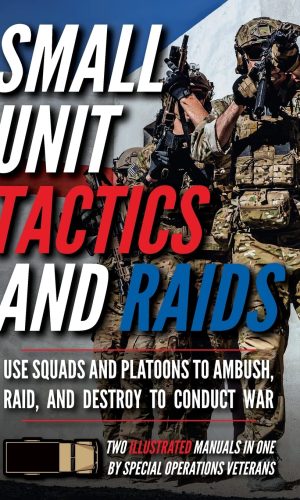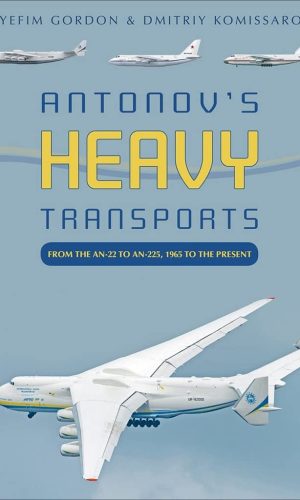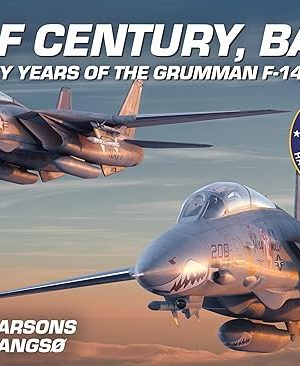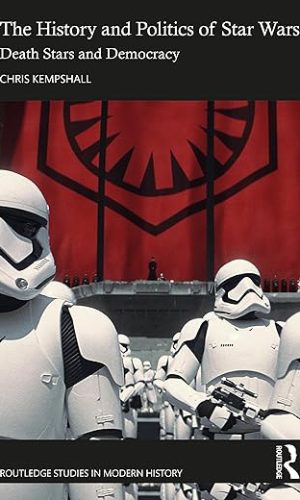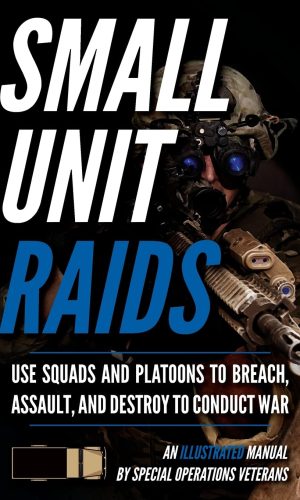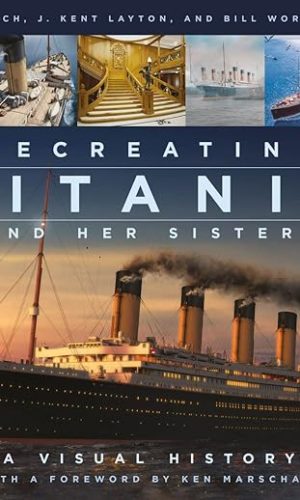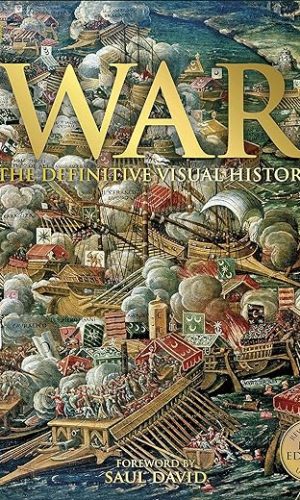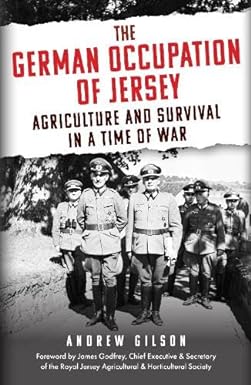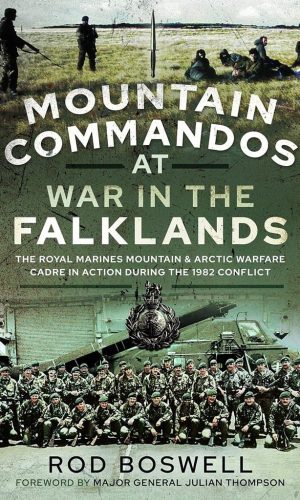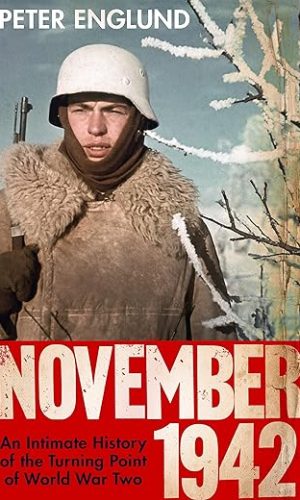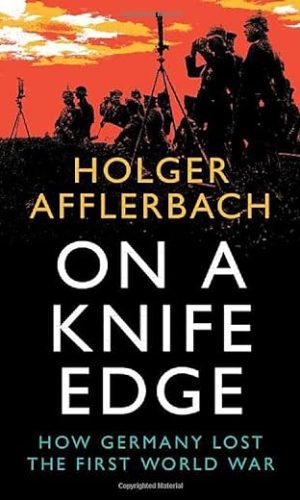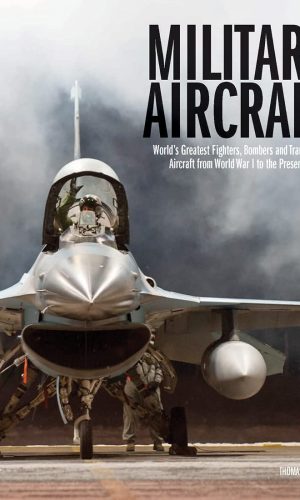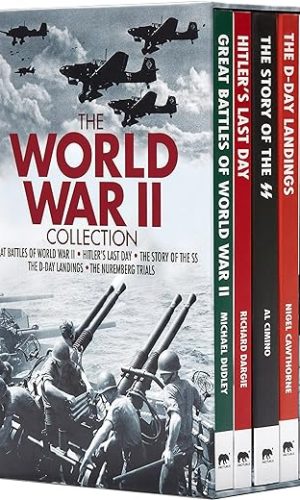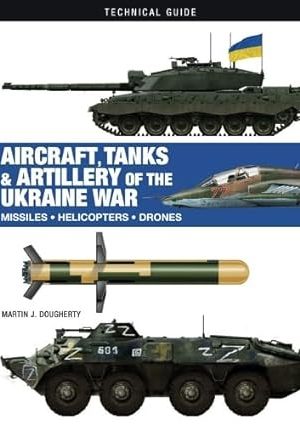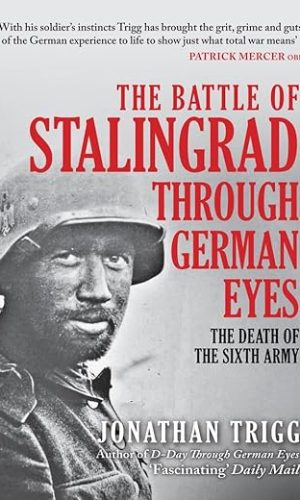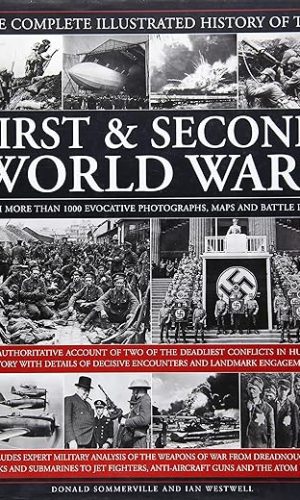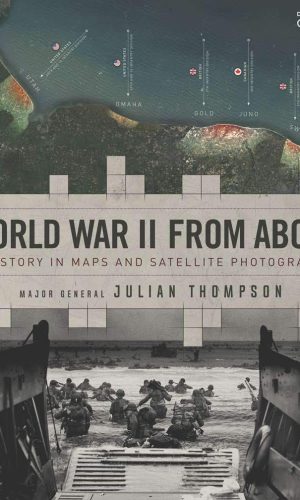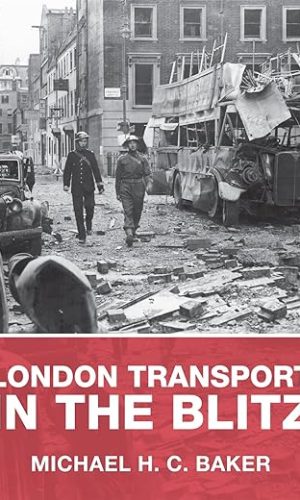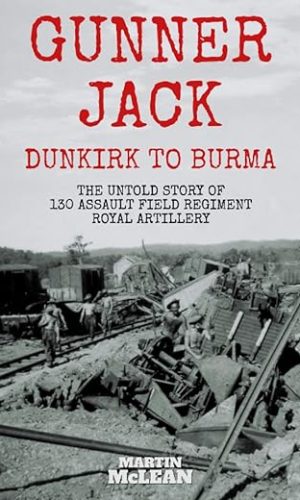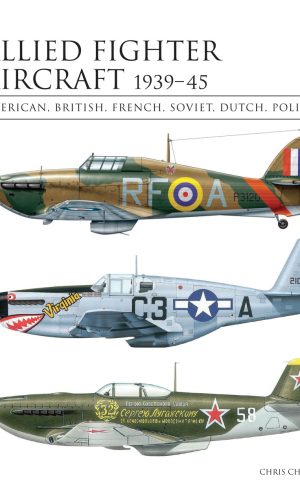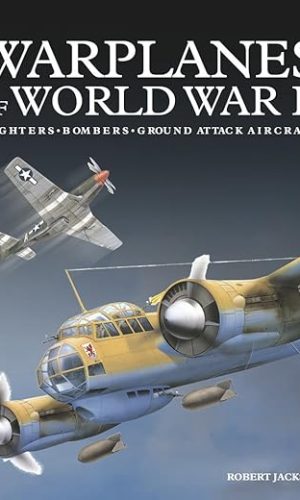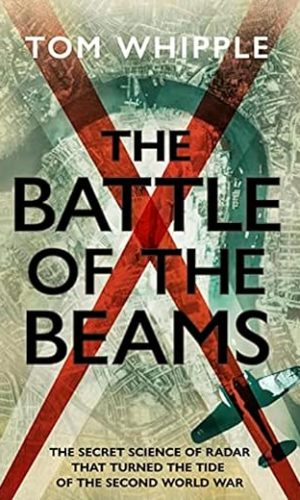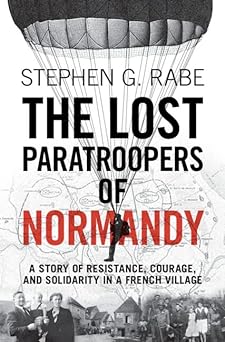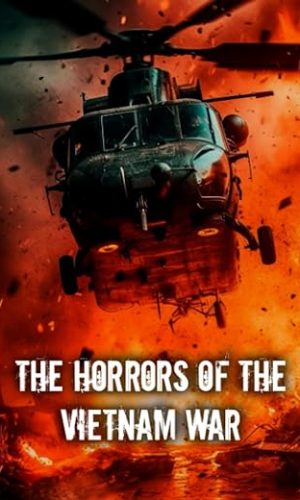Military History
-
Small Unit Tactics and Raids: Two Illustrated Manuals (Small Unit Soldiers)
Small Unit Soldiers use complex tactics and maneuvers to successfully ambush and raid the enemy. Each stage of a successful mission, from infiltration to attacking, requires professional skills and knowledge to flawlessly execute.
Special Operations Veterans teach these skills from experience using real-life examples in this combined printing of the two manuals, Small Unit Tactics and Small Unit Raids. The topics include: Transportation to the Objective, React to Enemy Contact, Military Operations in Urban Terrain (MOUT), Close Quarters Battle (CQB), Exfiltration, and more.
This book has over 500 full color images. Diagrams and photographs are critical to learning physical movements and coordinated maneuvers. These images are perfect for visual learners who are tired of mind-numbing walls of text.
Read more
£66.50 -
Antonov’s Heavy Transports: From the An-22 to An-225, 1965 to the Present
This book charts the development and service history of the Antonov design bureau’s heavy transport aircraft. In the late 1950s, the Antonov design bureau began developing the An-22 heavy military transport, intended to carry 50 tons. Powered by four 15,000 hp turboprops, it was the world’s heaviest transport when it first flew in February 1965. The four-turbofan An-124 was again the world’s most capable airlifter when it emerged in 1982, with a payload of 120 tons. It proved its worth in military and humanitarian operations and earned acclaim as a commercial freighter after 1991 for carrying heavy and outsized items. The unique six-engined An-225 “”Mriya”” was created for carrying the Buran space shuttle. Despite the demise of the Buran program, the aircraft found use on the heavy/outsized cargo transportation market. It is illustrated by a wealth of new photos and color artwork, as well as line drawings.-Read more
£44.80£55.10 -
Half Century, Baby! – Fifty Years of the Grumman F-14 Tomcat
Half Century, Baby! marks the 50th anniversary of the first two Grumman F-14A fleet squadrons (VF-1 and VF-2) receiving their first Tomcats during the summer of 1973. This lavishly illustrated volume tells the story of the aircraft from the beginning to its sunset of service with the US Navy in 2006; the longest operational career of any Naval Fighter to date. Preeminent Tomcat historian and former Tomcat RIO Dave Parsons explains the history of the F-14 decade by decade through the words of the aircrew who flew it. Artist Mads Bangsø brings his superlative illustration talents to the forefront with more than 120 F-14 profiles as well as highly accurate fully rendered recreations historical events featuring the Tomcat, highlighting the interesting markings of the aircraft (including helmets) as well as other aircraft associated with the Tomcat Community. The book features pertinent colour photography throughout, interwoven with the illustrations to complement the text.Read more
£40.00 -
Tort Law
Takes students from zero knowledge to engaged and critical thinkers.This best-selling undergraduate textbook from renowned authors Kirsty Horsey & Erika Rackley offers a lively, accessible, and thoughtful treatment of all key tort law topics, and includes carefully chosen learning features that encourage deep and critical thinking.
Key features:
– Problem questions at the beginning of chapters set the scene, immediately putting the law in context. Outline answers and an annotated version with issues and cases to consider offer students further insights
– Author videos in every chapter enliven, explain, and enrich key topics
– ‘Counterpoint’ and ‘pause for reflection’ boxes encourage students to think critically and engage with areas of controversy or reform
– Annotated statutes and judgments explain the more difficult points of law and help students develop the invaluable skills of reading, interpreting, and analysing
– Interactive decision trees provide a visual aid to understanding key torts, and cement that knowledge through direct, step-by-step engagementNew to this edition:
– Author videos and interactive decision trees
– New and updated coverage of key legal developments, including Banks v Cadwalladr [2022] EWHC 1417 (QB) on defamation, Bloomberg LP (Appellant) v ZXC (Respondent) [2022] UKSC 5 on privacy, and Paul v Royal Wolverhampton NHS Trust; Polmear v Royal Cornwall Hospital NHS Trust; Purchase v Ahmed [2022] EWCA Civ 12 on psychiatric harmDigital formats and resources:
This edition is available as an enhanced e-book, which offers an array of integrated resources to support learning. These include author videos, interactive decision trees, and support in tackling the problem question, as well as a mobile experience and convenient access, functionality tools, navigation features, and links: www.oxfordtextbooks.co.uk/ebooks http://www.oxfordtextbooks.co.uk/ebooksA selection of online resources is available to paperback, Law Trove, and enhanced e-book users, including:
– Outline answers to questions in the book
– Annotated links to external web resources and videos
– Downloadable annotated case judgments, statutes, and problem questions
– Guidance on answering problem and essay questions
– Additional content on elements of a claim in the tort of negligence and on product liability
– Access to the enhanced e-book’s videos and interactive decision treesRead more
£38.00Tort Law
£38.00 -
The History and Politics of Star Wars: Death Stars and Democracy (Routledge Studies in Modern History)
This book provides the first detailed and comprehensive examination of all the materials making up the Star Wars franchise relating to the portrayal and representation of real-world history and politics.
Drawing on a variety of sources, including films, published interviews with directors and actors, novels, comics, and computer games, this volume explores the ways in which historical and contemporary events have been repurposed within Star Wars. It focuses on key themes such as fascism and the Galactic Empire, the failures of democracy, the portrayal of warfare, the morality of the Jedi, and the representations of sex, gender, and race. Through these themes, this study highlights the impacts of the fall of the Soviet Union, the War on Terror, and the failures of the United Nations upon the ‘galaxy far, far away’. By analysing and understanding these events and their portrayal within Star Wars, it shows how the most popular media franchise in existence aims to speak about wider contemporary events and issues.
The History and Politics of Star Wars is useful for upper-level undergraduates, postgraduates, and scholars of a variety of disciplines such as transmedia studies, science fiction, cultural studies, and world history and politics in the twentieth and twenty-first centuries.
Read more
£29.80£34.20 -
The Last of the Windjammers: v. 2
The second volume embraces the period 1888-1928, forty hard years for the Windjammer. Mr. Lubbock’s virile pen draws wonderful word-pictures of the Last Boom in Sail · The Limejuicers of 1888-89 · The Carriers of the Nineties · The Square Riggers of the Twent eth Century, and so on. He has something to say on the Art of Handling Sail, the unique City of Hankow, Monster Sailing Ships, the capsizing of the Lodore and Blairmore, the naming of Masts, Law’s “Shires”, queer rigs, the wonderful Lancing, the Ports of the World, Weir’s “Banks”, Lost Arts of the Seaman, Clink’s Slowcoaches Shire Line, Captains, the “Glens”, German, Argentine, Norwegian, French, Belgian, Finnish and Danish Training Ships, The Reef Topsail Voice, and so on.Read more
£29.70 -
The Fourth Force: The Untold Story of the Royal Fleet Auxiliary Since 1945
Set up in August 1905, the Royal Fleet Auxiliary was originally a logistic support organization, part of the Navy proper but run on civilian lines, comprising a miscellaneous and very unglamorous collection of colliers, store ships and harbour craft. Just over a century later it has evolved beyond recognition: its ships compare in size, cost and sophistication with all but the largest warships, and the RFA itself has developed into an essential arm of all three Services. It is truly the Fourth Force as it is known to its own personnel and without it, the current worldwide deployment of British service men and women would be simply impossible. This book charts the veritable revolution that has overtaken the RFA since the end of the Second World War. New technology and techniques reflect the rapid growth in the importance of logistics in modern warfare, while the broadening role of the RFA is to be seen in the history of its operations, many of them little known to the public. Woven together from a combination of technical ship data, official correspondence and personal recollections, it is predominantly about the men and women of the RFA and their stories an insight into the underreported history of a service whose initials unofficially translate as Ready For Anything.Read more
£28.30 -
Small Unit Raids: An Illustrated Manual (Small Unit Soldiers)
Small Unit Raiders utilize advanced tactics known as Military Operations in Urban Terrain (MOUT) and Close Quarters Battle (CQB). These tactics prioritize swiftly moving into and out of enemy terrain to destroy, seize, and conduct information warfare.
Special Operations Veterans have written from their own experience with real-life examples, the step-by-step tactics that Soldiers must master. This manual explains in detail how to conduct a successful mission, from infiltration to raiding the enemy.
To completely explain every idea, this manual has over 320 full color images. Diagrams and photographs are critical to learning physical movements and coordinated maneuvers. These images are perfect for visual learners who are tired of mind-numbing walls of text.
Read more
£27.50 -
Recreating Titanic and Her Sisters: A Visual History
On the night of 14–15 April 1912, Titanic, a brand-new, supposedly unsinkable ship, the largest and most luxurious vessel in the world at the time, collided with an iceberg and sank on her maiden voyage. Of the 2,208 people on board, only 712 were saved. The rest perished in the icy-cold waters of the North Atlantic, and the tragedy has fascinated and perplexed the world ever since.
This stunning book tells the story of not just the Titanic, but also of its sister ships, Olympic and Britannic. Maritime experts J. Kent Layton, Tad Fitch, and Bill Wormstedt tell the stories of these legendary liners with a compelling narrative alongside original artwork from up-and-coming artists, bringing to life the design, construction and service of the ships together with the wrecks of the ill-fated Titanic and Britannic.
From the cold, starry night when Titanic collided with her iceberg to the tragic wartime loss of Britannic and the impressive reliability of the long-lived Olympic, this cinematic and immersive new study captures all of the glory and drama of the Olympic-class age and allows readers to visualise Titanic and her sisters like never before.
Read more
£25.70£38.00Recreating Titanic and Her Sisters: A Visual History
£25.70£38.00 -
War: The Definitive Visual History
Follow the epic 5,000-year story of warfare – from the earliest battles to the War on Terror – with this guided tour of every major conflict.
Combining a clear and compelling historical narrative with a wealth of fascinating eyewitness accounts and photography throughout, this is the ultimate guide to the history of military conflict, from the armies of ancient
Egypt to the rise of Isis in Syria and Iraq, and the ongoing Yemeni civil war.War explores the battles, the warriors, the tactics, and the weapons and technology that have shaped conflict worldwide. Lavishly illustrated with paintings, photographs, artefacts, and maps, this book offers a uniquely detailed and visually rich view of all major aspects of human conflict.
Whether on the bloody battlefields of the ancient world or in the modern era of drones and laser-guided missiles, this is the complete story of the wars that have shaped our world.
Read more
£23.80£28.50War: The Definitive Visual History
£23.80£28.50 -
The German Occupation of Jersey: Agriculture and Survival in a Time of War
On 1 July 1940 the Germans occupied Jersey and remained until the end of the war in Europe in May 1945. On Jersey, agriculture was the only economic activity left after the Germans arrived on the Island. It became the basis of Island life and, as the war wore on, the isolated Jersey became increasingly dependent on agriculture for its survival, particularly during near starvation in the winter of 1944. In this book local historian Andrew Gilson examines the relationship between the German Military Government and the civilian government and civil service on Jersey, and how they had to work together to ensure the Island’s survival through its farming industry. Based on hundreds of original documents from Jersey, including those held by the Royal Jersey Agricultural & Horticultural Society, other Channel Islands, Germany, France, Austria and elsewhere in Europe, the author reveals the complex relationship between the German occupiers, civilian authorities and the farming community. Accusations of collaboration and stories of sabotage, German exports of produce, the development of tobacco as a cash economy, the exploitation of Jersey cattle by Nazi scientists to create a new ‘superbreed’, German requisition of foodstuffs and the black market all played their part in this fascinating story. This groundbreaking and original study of the German occupation of Jersey will be of interest to all those wishing to know more about the history of Jersey as well as to military historians.Read more
£23.70£28.50 -
Hitler, Stalin, Mum and Dad: A Family Memoir of Miraculous Survival
THE INSTANT SUNDAY TIMES BESTSELLER
‘Epic, moving and important’ ROBERT HARRIS
‘A modern classic’ OBSERVER
‘An unforgettable epic of a book’DAILY MAIL
From longstanding political columnist and commentator Daniel Finkelstein, a powerful memoir exploring both his mother and his father’s devastating experiences of persecution, resistance and survival during the Second World War.
Daniel’s mother Mirjam Wiener was the youngest of three daughters born in Germany to Alfred and Margarete Wiener. Alfred, a decorated hero from the Great War, is now widely acknowledged to have been the first person to recognise the existential danger Hitler posed to the Jews and began, in 1933, to catalogue in detail Nazi crimes. After moving his family to Amsterdam, he relocated his library to London and was preparing to bring over his wife and children when Germany invaded the Netherlands. Before long, the family was rounded up, robbed and sent to starve in Bergen-Belsen.
Daniel’s father Ludwik was born in Lwów, the only child of a prosperous Jewish family. In 1939, after Hitler and Stalin carved up Poland, Ludwik’s father was arrested and sentenced to hard labour in the Gulag. Meanwhile, deported to Siberia and working as a slave labourer on a collective farm, Ludwik survived the freezing winters in a tiny house he built from cow dung.
Hitler, Stalin, Mum and Dad is a deeply moving, personal and at times horrifying memoir about Finkelstein’s parents’ experiences at the hands of the two genocidal dictators of the twentieth century. It is a story of persecution; survival; and the consequences of totalitarianism told with the almost unimaginable bravery of two ordinary families shining through.
‘Danny Finkelstein has written an elegant, moving account of the history of one family, and in doing so shines light on the history of the 20th century. If you want to understand Hitler and Stalin, read this book about people whose lives were upended by both of them’ ANNE APPLEBAUM, author of Gulag: A History, winner of the Pulitzer Prize
Daniel Finkelstein’s book ‘Hitler, Stalin, Mum and Dad’ was a Sunday Times bestseller w/c 26-06-2023.
Read more
£20.99£25.00 -
Forgotten War: The British Empire and Commonwealth’s Epic Struggle Against Imperial Japan, 1941–1945
The monumental struggle fought against Imperial Japan in the Asia/Pacific theater during World War II is primarily viewed as an American affair. While the United States did play a dominant role, the British and Commonwealth forces also made major contributions – on land, at sea and in the air – eventually involving over a million men and vast armadas of ships and aircraft. It was a difficult and often desperate conflict fought against a skilled and ruthless enemy that initially saw the British suffer the worst series of defeats ever to befall their armed forces. Still, the British persevered and slowly turned the tables on their Japanese antagonists. Fighting over an immense area that stretched from India in the west to the Solomon Islands in the east and Australia in the south to the waters off Japan in the north, British and Commonwealth forces eventually scored a string of stirring victories that avenged their earlier defeats and helped facilitate the demise of the Japanese Empire.Often overlooked by history, this substantial war effort is fully explored in Forgotten War. Meticulously researched, the book provides a complete, balanced and detailed account of the role that British and Commonwealth forces played on land, sea and in the air during this crucial struggle. It also provides unique analysis regarding the effectiveness and relevance of this collective effort and the contributions it made to the overall Allied victory.
Read more
£20.10£23.80 -
Mountain Commandos at War in the Falklands: The Royal Marines Mountain and Arctic Warfare Cadre in Action During the 1982 Conflict
Sunset, 8 June 1982, East Falkland. Eight specially trained Royal Marines infiltrate Goat Ridge, a long rocky hilltop between Mount Harriet and Two Sisters which are occupied by a battalion of 600 Argentine infantry. The next day, from their hiding place just metres away from the enemy, they note and sketch the Argentine positions, then withdraw as stealthily as they had come. Their daring patrol provides essential intelligence that guided the British assault which overwhelmed the Argentine defences two days later. This was just one example of the missions undertaken by the Royal Marines Mountain and Arctic Warfare Cadre during the Falklands War, all of which are described in graphic detail in Rod Boswell s eyewitness account. Using his own recollections and those of his comrades, he describes their operations in the Falklands the observation posts set up in the no man s land between San Carlos and Port Stanley, their role in the raid at Top Malo House, and the reconnaissance patrols they carried out close to the Argentine lines during the conflict. His first-hand account gives a fascinating insight into the operational skills of a small, specially trained unit and shows the important contribution it made to the success of the British advance. It also records the entire experience of the Falklands War from their point of view the long voyage south through the Atlantic, the landings, the advance and the liberation of Stanley.Read more
£20.00£23.80 -
The Royal Navy and Fishery Protection: From the Fourteenth Century to the Present
From the first recorded mention of British ships protecting of fishing vessels in the late fourteenth century through to recent controversies over the change in emphasis to border patrols and overseas deployments, the story of the Royal Navy’s ‘Cinderella Fleet’ involves many dramatic incidents; until now, however, there has never been a book dedicated to the subject. Naval historian Jon Wise’s new work will rectify this omission. Historically there have been two main reasons why protecting fishing vessels was so important: first, fish have always constituted an essential part of the nation’s diet while, secondly, fishermen have been an important source of skilled personnel for the Royal Navy itself. It is claimed that the Fishery Protection Squadron (FPS) is the oldest in the fleet, pre-dating the formal creation of the Navy itself in the early part of the sixteenth century, yet it still remains comparatively little-known. The Squadron’s most famous operations were the ‘Cod Wars’ of 1958–76, but for six centuries it has been engaged in the many important tasks of protection and policing of fishing fleets, though more recently it has turned its attention to patrolling oil and gas fields, overseeing quotas and sustainability, and policing the ongoing disagreements over who can fish where and when. The author covers subjects as diverse as the battles with the Dutch for dominance in the North Sea, the protection of fishing on the eastern seaboard of America, and the role of the Squadron in the two World Wars. Containing many first-hand accounts, this thought-provoking narrative will be of particular interest to all those RN personnel who have served in the Squadron, and is set to become the definitive account of this vital but often unsung component of Britain’s naval forces, and its impact on national life.Read more
£20.00£23.80 -
Ships of the Royal Navy: The Complete Record of all Fighting Ships of the Royal Navy from the 15th Century to the Present FULLY UPDATED AND EXPANDED
This is the fifth fully revised edition of a book first published in 1970. This longevity is testimony to its enduring value as a reference work indeed, Colledge (as it is universally known) is still the first stop for anyone wanting more information on any British warship from the fifteenth century to the present day when only the name is known. Each entry gives concise details of dimensions, armament and service dates, and its alphabetical and chronological arrangement makes it easy to track down the right ship (otherwise the Royal Navy s tradition of re-using the same names can be misleading). This new 5th edition contains some 200 new entries and revisions to many older entries. These reflect the demise of the post-Cold War ships as the Royal Navy was shrunk down as part of the peace dividend, and successive defence reviews saw the loss of significant ships classes such as the Type 42 destroyers, Type 22 frigates and the Illustrious class carriers. It is now being re-equipped in the face of new global challenges and has seen the introduction of the Queen Elizabeth class carriers, the largest ships ever built for the RN; the Type 45 destroyers; and Type 26 frigates and new patrol ships which will take on more global policing roles. Submarines should not be forgotten and the Cold War S class and T class are being replaced by the Astute class submarines, and the deterrent role, presently undertaken by the Vanguard class, is to be carried forward by the Dreadnought class submarines. Also included are the new RFAs which are increasingly taking on frontline operations to release the small number of escorts to more combative roles. In addition, there are updates to the Royal Australian, Canadian and New Zealand navies which have programmes to introduce new destroyers, Arctic patrol vessels, submarines and support ships. Since the death of Jim Colledge, who was widely respected for his pioneering research on the technical details of warships, his magnum opus has been updated, corrected and expanded with similar enthusiasm and attention to detail by Ben Warlow, a retired naval officer and author of a number of books in the field. Some press comments: A unique reference book which is the automatic starting point of research on Royal Navy ships. Lloyd s List This quite invaluable reference tool The Mariner s Mirror The book is absolutely essential in every naval historian s library. Warship WorldRead more
£20.00£23.80 -
November 1942: An Intimate History of the Turning Point of the Second World War
**A Telegraph Best History Book of 2023**
‘An astonishing achievement’ ANTONY BEEVOR
‘Extraordinary’ JULIA BOYDAn intimate history of the most important month of the Second World War – perhaps the century – as experienced by those who lived through it, completely based on their diaries, letters and memoirs.
At the beginning of November 1942, it looked as if the Axis powers could win the war; at the end of that month, it was obviously just a matter of time before they would lose.
In between came el-Alamein, Guadalcanal, the French North Africa landings, the Japanese retreat in New Guinea, and the Soviet encirclement of the German 6th Army at Stalingrad. In this innovatively kaleidoscopic and riveting historical marvel, Peter Englund reduces these epoch-making events to their basic component: the individual experience.
In thirty memorable days we meet characters including a Soviet infantryman at Stalingrad; an Italian truck driver in the North African desert; a partisan in the Belarussian forests; a machine gunner in a British bomber; a twelve-year-old girl in Shanghai; a university student in Paris; a housewife on Long Island; a prisoner in Treblinka; Albert Camus, Vasily Grossman, and Vera Brittain – forty characters in all. We also witness the launch of SS James Oglethorpe; the fate of U-604, a German submarine; the building of the first nuclear reactor; and the making of Casablanca.
Not since Englund’s own The Beauty and the Sorrow has a book given us one of the most dramatic periods of human history in all its immensity and emotional range.
‘Thought-provoking’ SUNDAY TIMES
‘Thoroughly worth reading’ TELEGRAPHRead more
£19.80£23.80 -
On a Knife Edge: How Germany Lost the First World War (Cambridge Military Histories)
Was the outcome of the First World War on a knife edge? In this major new account of German wartime politics and strategy Holger Afflerbach argues that the outcome of the war was actually in the balance until relatively late in the war. Using new evidence from diaries, letters and memoirs, he fundamentally revises our understanding of German strategy from the decision to go to war and the failure of the western offensive to the radicalisation of Germany’s war effort under Hindenburg and Ludendorff and the ultimate collapse of the Central Powers. He uncovers the struggles in wartime Germany between supporters of peace and hardliners who wanted to fight to the finish. He suggests that Germany was not nearly as committed to all-out conquest as previous accounts argue. Numerous German peace advances could have offered the opportunity to end the war before it dragged Europe into the abyss.Read more
£19.00£23.80 -
Military Aircraft: World’s Greatest Fighters, Bombers and Transport Aircraft from World War I to the Present: World’s Greatest Fighters, Bombers … War I to the Present (The…
Ever since man first took to the air, combat aircraft have been at the cutting edge of aviation technology, resulting in some of the greatest and most complex designs ever built. Military Aircraft features 52 of the most important military aircraft of the last hundred years. The book includes all the main types, from biplane fighters and carrier aircraft to tactical bombers, transport aircraft, multirole fighters, strategic strike aircraft and stealth bombers. Featured aircraft include: the Fokker Dr.1 triplane, the legendary fighter flown by German flying ace Manfred von Richthofen, ‘the Red Baron’, during World War I; the Mitsubishi A6M Zero, Japan’s highly-manoeuvrable fighter that dominated air-to-air combat in the early part of the Pacific War; the tank-busting Il-2 Shturmovik, the most produced aircraft in World War II; the Harrier jump jet, a vertical take-off and landing (VTOL) fighter that has been service for more than 40 years; the B-2 Spirit bomber, an American precision strike aircraft used in recent conflicts in Kosovo, Iraq and Afghanistan; and the F-22 Raptor, an air superiority fighter with state-of-the-art stealth technology that makes it almost invisible to radars. Each entry includes a brief description of the model’s development and history, a profile view, key features and specifications. Packed with more than 200 artworks and photographs, Military Aircraft is a colourful guide for the military aviation enthusiast.Read more
£18.60£23.70 -
1971: A People’s History from Bangladesh, Pakistan and India
The year 1971 exists everywhere in Bangladesh-on its roads, in sculptures, in its museums and oral history projects, in its curriculum, in people’s homes and their stories, and in political discourse. It marks the birth of the nation, its liberation. More than 1000 miles away, in Pakistan too, 1971 marks a watershed moment, its memories sitting uncomfortably in public imagination. It is remembered as the ‘Fall of Dacca’, the dismemberment of Pakistan or the third Indo-Pak war. In India, 1971 represents something else-the story of humanitarian intervention, of triumph and valour that paved the way for India’s rise as a military power, the beginning of its journey to becoming a regional superpower.
Navigating the widely varied terrain that is 1971 across Pakistan, Bangladesh and India, Anam Zakaria sifts through three distinct state narratives, and studies the institutionalization of the memory of the year and its events. Through a personal journey, she juxtaposes state narratives with people’s history on the ground, bringing forth the nuanced experiences of those who lived through the war. Using intergenerational interviews, textbook analyses, visits to schools and travels to museums and sites commemorating 1971, Zakaria explores the ways in which the year is remembered and forgotten across countries, generations and communities.
Read more
£18.00£20.90 -
The World War II Collection
A wonderful gift for any military history enthusiast.
This collection not only covers notable battles but also life under the Nazi regime and the trials that bought the regime’s figureheads to justice.
This handsome box set brings together five titles which recount the major events of World War II, from Dunkirk to the Nuremberg trials. With breakdowns of skillful military manoeuvres, chilling accounts of Nazi organizations and astounding details from the fall of Berlin, this collection chronicles the defeat of Germany and the Axis powers.
These titles are:
• Great Battles of World War II by Michael Dudley
• The D-Day Landings by Nigel Cawthorne
• Hitler’s Last Day by Richard Dargie
• The Story of the SS by Al Cimino
• The Nuremberg Trials by Alexander MacdonaldA great read for both military history enthusiasts and those eager to learn more about World War II.
Read more
£18.00The World War II Collection
£18.00 -
The Silent Deep: The Royal Navy Submarine Service Since 1945
‘The Ministry of Defence does not comment upon submarine operations’ is the standard response of officialdom to enquiries about the most secretive and mysterious of Britain’s armed forces, the Royal Navy Submarine Service. Written with unprecedented co-operation from the Service itself and privileged access to documents and personnel, The Silent Deep is the first authoritative history of the Submarine Service from the end of the Second World War to the present. It gives the most complete account yet published of the development of Britain’s submarine fleet, its capabilities, its weapons, its infrastructure, its operations and above all – from the testimony of many submariners and the first-hand witness of the authors – what life is like on board for the denizens of the silent deep.
Dramatic episodes are revealed for the first time: how HMS Warspite gathered intelligence against the Soviet Navy’s latest ballistic-missile-carrying submarine in the late 1960s; how HMS Sovereign made what is probably the longest-ever trail of a Soviet (or Russian) submarine in 1978; how HMS Trafalgar followed an exceptionally quiet Soviet ‘Victor III’, probably commanded by a Captain known as ‘the Prince of Darkness’, in 1986. It also includes the first full account of submarine activities during the Falklands War. But it was not all victories: confrontations with Soviet submarines led to collisions, and the extent of losses to UK and NATO submarine technology from Cold War spy scandals are also made more plain here than ever before.
In 1990 the Cold War ended – but not for the Submarine Service. Since June 1969, it has been the last line of national defence, with the awesome responsibility of carrying Britain’s nuclear deterrent. The story from Polaris to Trident – and now ‘Successor’ – is a central theme of the book. In the year that it is published, Russian submarines have once again been detected off the UK’s shores. As Britain comes to decide whether to renew its submarine-carried nuclear deterrent, The Silent Deep provides an essential historical perspective.
Read more
£17.10£19.00 -
Aircraft, Tanks and Artillery of the Ukraine War (Technical Guides)
Illustrated with accurate artworks of aircraft, armoured fighting vehicles, artillery and missiles, Aircraft, Tanks & Artillery of the Ukraine War is a detailed guide to all the weaponry currently being deployed in the War in Ukraine. The War in Ukraine is being fought using tanks, aircraft and artillery dating from the Cold War deployed alongside state-of-the-art weapons systems supplied by Western powers. Arranged chronologically by type, Aircraft, Tanks & Artillery of the Ukraine War offers a complete survey of the weapons deployed, from the venerable Ilyushin Il-76 strategic airlifter and T-64 medium tank to the latest American-made M142 HIMARS rocket artillery and the Bayraktar TB2 combat drone. The guide is illustrated with accurate profile artworks of fighter aircraft, bombers, attack helicopters, tanks, APCs, artillery systems, missile launchers and unmanned aerial vehicles from Russian, NATO, Turkish and other sources. Illustrated with more than 100 detailed artworks, Aircraft, Tanks & Artillery of the Ukraine War is an essential reference guide for those who want to understand the war being fought in Europe today.
Read more
£17.10 -
Modern Chinese Military Aircraft (Technical Guides): 1990-Present
Illustrated with accurate artworks of military aircraft and their markings, Modern Chinese Military Aircraft is a detailed guide to all the aircraft types deployed by the People’s Republic of China from 1990 to the present. Arranged chronologically by type, the book covers everything from the venerable Cold War era Chengdu J-7, a third-generation fighter still in service, to the J-10 ‘Vigorous Dragon’ multirole fighters that patrol the Taiwan Straits today. The guide is illustrated with accurate profile artworks of some of the best – and least – known aircraft, such as the Shenyang J-8 interceptor, which served in the late Cold War in great numbers and was a copy of the Soviet MiG-21; the anti-tank armed Harbin Z-9 helicopter; the Shenyang J-15 carrier-based fourth-generation multirole fighter; the Caihong 4 surveillance drone; and the latest Chengdu J-20. Illustrated with more than 100 detailed artworks, Modern Chinese Military Aircraft is an essential reference guide for modellers and enthusiasts of military aviation.
Read more
£17.10 -
The Battle of Stalingrad Through German Eyes: The Death of the Sixth Army
Five months, one week and three days of hell. The German offensive to capture Stalingrad began in August 1942, using Friedrich Paulus’s 6th Army and elements of the 4th Panzer Army. The attack was supported by intense bombing that reduced much of the city to rubble. The battle degenerated into house-to-house fighting, as both sides fought for the city on the Volga. By mid-November, the Germans were on the brink of victory as the Soviet defenders clung on to a final few slivers of land along the west bank of the river. Then, on 19 November, the Red Army launched Operation Uranus, targeting the weaker Romanian armies protecting the 6th Army’s flanks. The ill-equipped Romanians were overrun and the 6th Army was cut off and surrounded. Hitler was determined to hold the city – the symbolic namesake of the Soviet leader – and forbade the 6th Army from attempting a breakout, insisting they be supplied by air instead; in February 1943, without food or ammunition, some 91,000 starving, lice-ridden Germans surrendered. The losses on both sides were eye-watering – the Soviets alone suffered something approaching half a million dead and more than 650,000 sick or wounded – and in his unique style author Jonathan Trigg reveals the human agony behind such statistics through the words of the Germans who were there. Was it all over after the surrender? Of course not. Death marches did for many: Landser Josef Farber remembered: ‘We set out with 1,200 men … about 120 were alive when we reached the camp.’ This was war at its rawest – this was Stalingrad.Read more
£16.70£19.00 -
The Complete Illustrated History of the First & Second World Wars: With More Than 1000 Evocative Photographs, Maps and Battle Plans
This comprehensive history begins by looking at the origins of WWI and then chronicles the war a year at a time. The second half of the book details the history of WWII, from the rise of Hitler and the persecution of the Jewish race to the attacks on Pearl Harbor and the dropping of the atom bombs. All aspects of war are covered including war illnesses, espionage, propaganda and the atrocities on all sides. There are special features dedicated to the weaponry and tactics that shaped the wars. Written by experts in their field and illustrated with over 1000 photographs, battle plans and maps, it is a fascinating guide for both specialist and general readers.Read more
£16.70£19.00 -
World War II from Above: A History in Maps and Satellite Photographs
World War II from Above offers a never-before-seen combination of annotated satellite images and expertly drawn battle maps. It aims to satisfy both the military history buff and those seeking a visually stunning history gift book, bringing the war vividly and dramatically to life by showing the actual landscapes where battles took place along with specially commissioned annotations depicting remarkable events, troop movements, heroic last stands, or even where individual soldiers stood or fell.
Each of the 25 chapters features an enhanced Google Earth image, along with specially commissioned battle maps showing every facet of the conflict in exceptional detail.
Here you will find all the key milestones of World War II: the invasion of France, Germany’s first blitzkrieg offensives, the Battle of Alamein, Monte Cassino, Arnhem, the invasion of Sicily, the Battle of the Bulge, Iwo Jima, D-Day and the final push to Berlin, along with a host of other strategic and battle maps from every geographical location.
Written by a highly decorated soldier and leading military history expert, this is an innovative, richly detailed and visually stunning overview of history’s most destructive conflict.
Read more
£16.50£19.00 -
London Transport in the Blitz
Up until the twentieth century, wars were fought on the battlefield; it rarely impacted the civilian population. All this changed with the development of aircraft; suddenly there was an additional dimension to warfare. World War 1 saw the first limited raids on urban areas, but it was World War 2 that forced Britains towns and cities onto the front line. While many town and cities suffered severe damage, it was the greater London area that sustained the longest and most damaging onslaught from the early bombing raids of 1940 through to the V1s and V2s of the later years of the war. Central to the viability of the city during the war was London Transport; not only did its Underground stations provide essential additional air raid shelters, but its buses, trains, trams, and trolley buses had to continue to operate throughout the period, despite sustaining vast damage to vehicles and infrastructure. This book tells its fascinating story.Read more
£16.30£19.00London Transport in the Blitz
£16.30£19.00 -
Gunner Jack Dunkirk to Burma: The Untold Story of 130 Assault Field Regiment Royal Artillery
‘Churchill needed a victory and it was decided that we were just the lads to do it, and retake Burma without aircraft, just brute force and ignorance.’
– Alf Smith, D Troop, 316 Battery, 130th (Lowland) Field RegimentThe Lowlanders had a hell of a war. Despatched to the far side of the globe to face the merciless might of the Imperial Japanese Army, this steadfast band of volunteers and conscripts endured operations that are now all but forgotten, overlooked in even the most comprehensive published histories of the Second World War.
They were ordinary men facing extraordinary horrors, a gang of amateurs forged into a crack unit that took on some of the Royal Artillery’s toughest engagements in Burma. Drawing upon hundreds of archive documents, unpublished memoirs and declassified reports, their astonishing story of hardship, humour and heroism is told here for the first time. This painstakingly-researched book traces their journey from enlistment to demob, examining the battles they fought, the way they lived, and the triumphs and tragedies they experienced along the way. It weaves together the grand strategies of politicians and generals with first-hand accounts from those at the sharp end, from the gunners on the ground, to the infantry they supported, to the pilots battling for the skies above them.
‘Screaming shells were exploding everywhere. I threw myself hard against a fallen tree and could hardly believe it was our own guns… I could feel my body being violently compressed with every explosion. The pungent smell of cordite was everywhere while the shrapnel whined all around us.’
– Bill Bryden, F Troop, 494 Battery, 130th (Lowland) Field RegimentThe narrative follows Jack McLean, who as a reckless teenager joined his local Territorial Army unit (139th Field Regiment: the Lewisham Gunners) shortly before the outbreak of the Second World War. Sent to join the British Expeditionary Force in France, after gamely standing on the Escaut Line against experienced German troops he was evacuated through Dunkirk. As Britain braced for invasion, young Jack was ordered to join the untested 130th (Lowland) Field Regiment to offer it the benefit of his ‘battle experience’.
Despite a faltering start with antiquated equipment, the Lowlanders were soon sent over the ocean to take part in the first foray back into Burma after the Japanese invasion. They were hardened in the Somme-like slaughter of Donbaik and, as 1943’s ill-fated Cannibal expedition descended into catastrophe, fought for their lives on the palm-fringed shores of the Bay of Bengal, surrounded on the beach with their backs to the sea.
‘The gunners leaned out with their rifles at the ready. If ever men prayed hard, we who watched did then. Lurching and heaving, the good old ‘Quad’ waded through, and the gunners, yelling like mad, opened fire with their rifles as they passed the ill-fated copse.’
– Ronnie Nicholson, Regimental Headquarters, 130th (Lowland) Field RegimentLater, as an experimental ‘assault’ regiment in a unique Combined Operations formation, they held the line against the shock Japanese Arakan offensive of 1944. Ultimately assigned to a fractious multi-national task force headed by notorious American general ‘Vinegar Joe’ Stilwell, their war culminated in a ten-month, thousand-mile slog through monsoon rains and remote mountainous jungle to reach Mandalay, chasing a stubborn enemy rearguard through country that was eminently suited to the tactics of ambush and infiltration for which the Japanese soldier was rightly feared and admired.
Until now, surviving details of their staggering feat of human endurance have lain buried in archives, a neglected sideshow to an ill-remembered theatre of conflict; the forgotten of the Forgotten Army.
Read more
£16.10 -
British Transport Aircraft of the 1970s and ’80s (Historic Military Aircraft)
Following on in the series of British aircraft in the 1970s and ’80s, this book explores the transport aircraft that served during this time period, including the Argosy, Belfast, Hastings and more.Read more
£16.10 -
Arctic Convoys: Bletchley Park and the War for the Seas
An incisive account of the Arctic convoys, and the essential role Bletchley Park and Special Intelligence played in Allied success
Between 1941 and 1945, more than eight hundred shiploads of supplies were delivered to the Soviet Union protected by allied naval forces. Each journey was a battle against the elements, with turbulent seas, extreme cold, and the constant dread of torpedoes. These Arctic convoys have been mythologized as defenseless vessels at the mercy of deadly U-boats―but was this really the case?
David Kenyon explores the story of the war in the Arctic, revealing that the contest was more evenly balanced that previously thought. Battles included major ship engagements, aircraft carriers, and combat between surface ships. Amid this wide range of forces, Bletchley Park’s Naval Section played a decisive role in Arctic operations, with both sides relying heavily on Signals Intelligence to intercept and break each other’s codes. Kenyon presents a vivid picture of the Arctic theater of war, unearthing the full-scale campaign for naval supremacy in northern waters.Read more
£15.70£19.00 -
Allied Fighter Aircraft 1939–45: American, British, French, Soviet, Dutch, Polish (Identification Guide)
Allied Fighters 1939–45 offers an highly-illustrated guide to Allied fighter aircraft that fought in Europe during World War II. Featuring all the main models flown by the Allied air forces from 1939 to 1945, the book offers a wealth of detail, including unit markings, organization, numbers of aircraft flown by campaign and exhaustive specifications for each model. The book is arranged first by country and then chronologically by campaign so that every aspect of the air war in Europe is covered. The guide features fighters from throughout World War II, including early models, such as the Morane Saulnier MS.406C.1, Hawker Hurricane Mk I and Fokker D XXI, and the most advanced fighters of the period, such as the Lavochkin La-7, P-51K Mustang and Gloster Meteor Mk I.The book also covers aircraft that were used for air-to-air combat (Supermarine Spitfire), ground attack (P-47 Thunderbolt), bomber escort (P-51B Mustang), night defence (Bristol Beaufighter) and photographic reconnaissance (P-38 Lightning). Packed with more than 200 profiles and dozens of archive photographs of every major Allied fighter aircraft, Allied Fighters 1939–45 is a core reference volume for modellers and World War II aviation enthusiasts.Read more
£15.60£19.00 -
Warplanes of World War II: Fighters, Bombers, Ground Attack Aircraft
Warplanes of World War II provides a detailed look at 50 key aircraft in service between 1939 and 1945. Warplanes profiled include fighters, bombers, fighter- bombers, ground attack and other aircraft from the US, USSR, Germany, UK, Japan, France, Poland and Italy. A large-format side-on photograph in full colour shows every detail of each aircraft, with notes pointing out features that made it unique. This is followed by an in-depth description of the aircraft’s development, manufacturing history and technical profile – all accompanied by colour photographs and a detailed specification panel.
Read more
£15.60£19.00 -
The Battle of the Beams: The secret science of radar that turned the tide of the Second World War
‘Deeply researched and engagingly written’ The Times
‘Has the pace and style of a well-crafted thriller’ Mail on Sunday
‘Chock full of memorable characters and written with all the drama and pace of a Robert Harris thriller’ Rowland White, author of Harrier 809The radio war of 1939-45 is one of the great scientific battles in history.
This is the story of that war.Relying on first-hand accounts as well as papers recently released by the Admiralty, The Battle of the Beams fills a huge missing piece in the canon of WW2 literature.
It combines history, science, derring do and dogged determination and will appeal as much to fans of WW2 history as to those fascinated by the science behind the beams that changed our lives.
The British believed that, through ingenuity and scientific prowess, they alone have a war-winning weapon: radar. They are wrong. The Germans have it too.
They believe that their unique maritime history means their pilots have no need of navigational aids. Flying above the clouds they, like the seafarers of old, had the stars to guide them, and that is all that is required. They are wrong. Most of the bombs the RAF will drop in the first years of the war land miles from their target.
They also believe that the Germans, without the same naval tradition, will never be able to find targets at night. They are, again, wrong. In 1939 the Germans don’t just have radar to spot planes entering their airspace, they have radio beams to guide their own planes into enemy airspace.
Luckily there was one young engineer, Reginald Jones, helping the British government with their own scientific developments. In June 1940, when Jones quietly explained the beams the Germans had devised to a room full of disbelieving sceptics, Churchill later described the moment as like sitting in the parlour while Sherlock Holmes finally reveals the killer. Churchill immediately supported Jones’s efforts to develop radar technology that went on to help the Allies win the war.
Read more
£15.20£19.00 -
P-38 Lightning Illustrated
The more than 10,000 Lockheed P-38 Lightnings produced during World War II do not even place it in the top 15 combat aircraft produced during that conflict. And yet, the Lightning is one of the most dynamic and successful fighters of that era. The P-38 was the first Lockheed-designed military airplane to be mass produced, and the first twin-engine interceptor flown by the U.S. Army Air Forces. Up until its introduction, most fighters were powered by air-cooled radial engines. The Lightning was powered by a pair of liquid-cooled Allison V-1710 in-line engines. Likewise, fighters….in fact, most….military aircraft were “tail draggers”, but the Lightning was the first modern fighter with tricycle landing gear. The design of the P-38 was radical…..the twin-boom layout….the bubble canopy, and the flush-riveted skins which lowered drag to a point that the Lightning was the first fighter capable of speeds over 400mph made it unique. That radical design also made growth versions possible, and it was the only U.S. fighter whose production spanned the entire war years. When it went into action, it was the first American fighter to shoot down a German airplane and the first fighter capable of escorting bombers all the way to Berlin. It was the mount of the two highest-scoring American aces of the war. P-38s accounted for more Japanese aircraft destroyed than any other single fighter. The speed and high-altitude performance of the Lightning made it the preeminent photo reconnaissance platform of the war. The versatility of the design included ground attack and night fighter missions. The P-38 Lightning was, indeed, one of the most effective and celebrated aircraft of WWII. This pictorial record of the P-38 includes dozens of color photos as well as drawings and period advertisements featuring the iconic P-38 Lightning.
Read more
£15.10P-38 Lightning Illustrated
£15.10 -
Miss Dior: A Wartime Story of Courage and Couture
Miss Dior is a wartime story of freedom and fascism, beauty and betrayal and ‘a gripping story’ (Antonia Fraser).
‘Exceptional . . . Miss Dior is so much more than a biography. It’s about how necessity can drive people to either terrible deeds or acts of great courage, and how beauty can grow from the worst kinds of horror.’
DAILY TELEGRAPHMiss Dior explores the relationship between the visionary designer Christian Dior and his beloved younger sister Catherine, who inspired his most famous perfume and shaped his vision of femininity. Justine Picardie’s journey takes her to wartime Paris, where Christian honed his couture skills while Catherine dedicated herself to the French Resistance and the battle against the Nazis, until she was captured by the Gestapo and deported to the German concentration camp of Ravensbrück.
Tracing the wartime paths of the Dior siblings leads Picardie deep into other hidden histories, and different forms of resistance and sisterhood. She discovers what it means to believe in beauty and hope, despite our knowledge of darkness and despair, and reveals the timeless solace of the natural world in the aftermath of devastation and destruction.
*A beautiful, full colour package featuring over 200 archival images.*
‘Extraordinary . . . Picardie uses her investigative reporting skills . . . the result is Netflix-worthy and the pace page-turning . . . Catherine’s story shines – the quiet Dior who preferred flowers to fashion, the unsung heroine who survived the abuse of the Third Reich to help liberate France.’
SUNDAY TIMESRead more
£14.60£19.00Miss Dior: A Wartime Story of Courage and Couture
£14.60£19.00 -
The Lost Paratroopers of Normandy: A Story of Resistance, Courage, and Solidarity in a French Village
The fateful days and weeks surrounding 6 June 1944 have been extensively documented in histories of the Second World War, but less attention has been paid to the tremendous impact of these events on the populations nearby. The Lost Paratroopers of Normandy tells the inspiring yet heartbreaking story of ordinary people who did extraordinary things in defense of liberty and freedom. On D-Day, when transport planes dropped paratroopers from the 82nd and 101st Airborne Divisions hopelessly off-target into marshy waters in northwestern France, the 900 villagers of Graignes welcomed them with open arms. These villagers – predominantly women – provided food, gathered intelligence, and navigated the floods to retrieve the paratroopers’ equipment at great risk to themselves. When the attack by German forces on 11 June forced the overwhelmed paratroopers to withdraw, many made it to safety thanks to the help and resistance of the villagers. In this moving book, historian Stephen G. Rabe, son of one of the paratroopers, meticulously documents the forgotten lives of those who participated in this integral part of D-Day history.Read more
£14.30£19.00 -
The Wager
*LONGLISTED FOR THE 2023 BALLIE GIFFORD PRIZE FOR NON-FICTION*‘The beauty of The Wager unfurls like a great sail… one of the finest nonfiction books I’ve ever read’ Guardian
‘The greatest sea story ever told’ Spectator
‘A cracking yarn… Grann’s taste for desperate predicaments finds its fullest expression here’ Observer
THE INSTANT NEW YORK TIMES NO. 1 BESTSELLER
From the international bestselling author of KILLERS OF THE FLOWER MOON and THE LOST CITY OF Z, a mesmerising story of shipwreck, mutiny and murder, culminating in a court martial that reveals a shocking truth.
On 28th January 1742, a ramshackle vessel of patched-together wood and cloth washed up on the coast of Brazil. Inside were thirty emaciated men, barely alive, and they had an extraordinary tale to tell. They were survivors of His Majesty’s ship the Wager, a British vessel that had left England in 1740 on a secret mission during an imperial war with Spain. While chasing a Spanish treasure-filled galleon, the Wager was wrecked on a desolate island off the coast of Patagonia. The crew, marooned for months and facing starvation, built the flimsy craft and sailed for more than a hundred days, traversing 2,500 miles of storm-wracked seas. They were greeted as heroes.
Then, six months later, another, even more decrepit, craft landed on the coast of Chile. This boat contained just three castaways and they had a very different story to tell. The thirty sailors who landed in Brazil were not heroes – they were mutineers. The first group responded with counter-charges of their own, of a tyrannical and murderous captain and his henchmen. While stranded on the island the crew had fallen into anarchy, with warring factions fighting for dominion over the barren wilderness. As accusations of treachery and murder flew, the Admiralty convened a court martial to determine who was telling the truth. The stakes were life-and-death—for whomever the court found guilty could hang.
Read more
£14.30£19.00The Wager
£14.30£19.00 -
The Horrors Of The Vietnam War: Discover the Hidden Faces of Conflict and the Indelible Scars of War
The horrors of the Vietnam War: an unprecedented journey to the heart of a devastating conflictAre you passionate about history, eager to understand the events that shaped the world and their consequences? Then you’ve come to the right place! Discover “The Horrors of the Vietnam War”, a deep and shocking dive into one of the most controversial and deadly conflicts of the twentieth century. By reading this book, you will not only grasp the geopolitical stakes, but also understand the unimaginable suffering of the people, the atrocities committed and the lessons to be learned for the future.
A. Historical and geopolitical context: the origins of a multi-faceted conflict
From the very first pages, you will be immersed in the historical context of the Vietnam War. You will discover how French colonisation, the Indochina War and the Geneva Conference contributed to the emergence of this bloody conflict. In addition, you will explore the crucial role of the Cold War, the doctrine of containment and nationalist motivations in escalating tensions.B. The players in the conflict: the forces involved and their motivations
Who were the belligerents in this devastating war? You will learn all about the North Vietnamese and Vietcong forces, the South Vietnamese government, the United States and its allies, as well as the USSR and China. By understanding their motivations and objectives, you’ll be able to better grasp the reasons behind the horrors committed on the battlefield.C. Chronology of events: a war with many turning points
By following the chronology of major events step by step, you will experience the key moments of the Vietnam War, from the first American interventions to the fall of Saigon and the reunification of the country. You will witness the massive bombings, the use of chemical weapons and the atrocities committed against the civilian population.D. The human and environmental consequences: a nameless horror
The loss of human life, the destruction of property and the suffering of the people are at the heart of this book. You will discover the health and environmental after-effects of this war, in particular the impact of Agent Orange, deforestation and the loss of biodiversity. The poignant testimonies of survivors and refugees will touch your soul.E. The role of the media and public opinion: unprecedented awareness
How was the Vietnam War perceived by the whole world? You will explore the impact of the media and media coverage of the conflict, as well as the rise of opposition to the war, particularly through emblematic reports and photographs. You will understand how this awareness influenced public opinion and international demonstrations against the war.F. The lessons and legacy of the Vietnam War: a future not to be repeated
Finally, you will discover the strategic, tactical and political mistakes made during the war, as well as the political and diplomatic consequences. This book invites you to reflect on the lessons to be learned from these horrors to prevent future conflicts and the reconciliation and reconstruction efforts that followed the end of the war.Don’t miss this unique opportunity to discover “The horrors of the Vietnam War”!
By reading this book, you will be transported to the heart of one of the most significant wars in modern history, and you will come away transformed. Don’t miss this chance to immerse yourself in a captivating story, rich in detail and moving testimony. Buy “The Horrors of the Vietnam War” now and enjoy an unforgettable literary experience!Read more
£14.20 -
The Pussers Cook Book: Traditional Royal Navy recipes
This is the revised and updated edition of The Pussers Cook Book- recipes
- Dits
- tidbits
- facts
- memoriesThe Pussers Cook Book contains many of the most popular and loved traditional dishes served in the Royal Navy’s Galleys from the mid-1960s to the early 1980s.
Some of these dishes are being served on the ships and shore bases of today’s modern navy, although some have been slightly altered and others given, let’s say, more politically correct names.
Woven between the recipes in this book are true facts and tidbits about the food, the cooks and general life aboard ship.
Along with the recipes, this book aims to preserve a segment of British history, Royal Navy social history, which is fading all too quickly and would otherwise be lost in the grey sea-mists of oblivion.
Read more
£14.00

